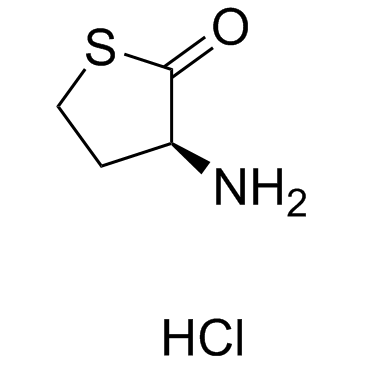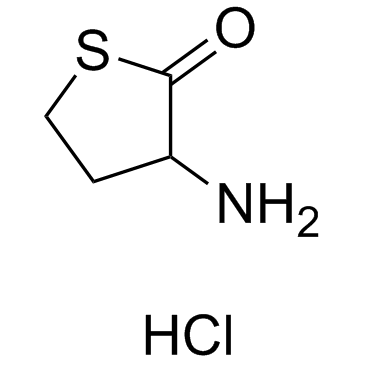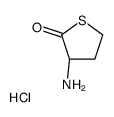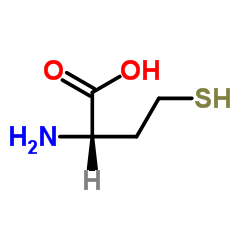L-Homocysteine thiolactone hydrochloride

L-Homocysteine thiolactone hydrochloride structure
|
Common Name | L-Homocysteine thiolactone hydrochloride | ||
|---|---|---|---|---|
| CAS Number | 31828-68-9 | Molecular Weight | 153.630 | |
| Density | N/A | Boiling Point | 253.8ºC at 760mmHg | |
| Molecular Formula | C4H8ClNOS | Melting Point | 185-191ºC | |
| MSDS | USA | Flash Point | 107.3ºC | |
Use of L-Homocysteine thiolactone hydrochlorideL-Homocysteine thiolactone hydrochloride is an intramolecular thioester of homocysteine; prevents translational incorporation of homocysteine into proteins. |
| Name | L-2-Amino-4-mercaptobutyric acid 1,4-thiolactone hydrochloride |
|---|---|
| Synonym | More Synonyms |
| Description | L-Homocysteine thiolactone hydrochloride is an intramolecular thioester of homocysteine; prevents translational incorporation of homocysteine into proteins. |
|---|---|
| Related Catalog | |
| In Vitro | In all cell types, from bacterial to human, homocysteine is metabolized to homocysteine thiolactone by methionyl-tRNA synthetase. Elevated levels of homocysteine are an independent risk factor for cardiovascular disease in humans. Homocysteine can be harmful to human cells because of its metabolic conversion to homocysteine thiolactone, a reactive thioester. This conversion occurs in all human cell types, including endothelial cells[1]. Homocysteine thiolactone induces cell death and features of apoptosis including increased phosphotidylserine exposure on the membrane surface, increased apoptotic cells with hypoploid DNA contents, and internucleosomal DNA fragmentation in HL-60 cells[2]. Homocysteine thiolactone is cytotoxic and capable of promoting cell death, as measured by caspase-3 activation and DNA fragmentation. HcyT strongly activates IL-8 release[3]. |
| In Vivo | Homocysteine thiolactone is toxic, induces epileptic seizures in rodents, and has been implicated in Alzheimer’s disease[4]. Homocysteine thiolactone induces two types of seizures, the coexistence of convulsive and nonconvulsive epilepsy. The grade of seizures is dose dependent[5]. |
| Cell Assay | HUVEC are treated with homocysteine (1, 5, 10 mM) or homocysteine thiolactone (0.25, 0.5, 1 mM) for 3, 6, 12 and 24 h. Cell survival is determined by the MTT method. The optical density is measured at 570 nm with 630 nm as a reference[3]. |
| Animal Admin | Rats: Homocysteine thiolactone is freshly prepared in saline and administered in a volume of 1.0 mL/100 g body weight. Rats are divided into control (saline-injected) group and homocysteine thiolactone-treated group. The latter group receives different doses 5.5 mM/kg, 8.0 mM/kg, and 11.0 mM/kg, respectively. Each rat is used only once[5]. |
| References |
| Boiling Point | 253.8ºC at 760mmHg |
|---|---|
| Melting Point | 185-191ºC |
| Molecular Formula | C4H8ClNOS |
| Molecular Weight | 153.630 |
| Flash Point | 107.3ºC |
| Exact Mass | 153.001511 |
| PSA | 68.39000 |
| LogP | 1.47950 |
| Storage condition | 2-8℃ |
| Personal Protective Equipment | Eyeshields;Gloves;type N95 (US);type P1 (EN143) respirator filter |
|---|---|
| Safety Phrases | S22-S24/25 |
| RIDADR | NONH for all modes of transport |
| HS Code | 2934999090 |
|
~% 
L-Homocysteine ... CAS#:31828-68-9 |
| Literature: EP1964838 A1, ; Page/Page column 5 ; |
|
~% 
L-Homocysteine ... CAS#:31828-68-9 |
| Literature: EP1964838 A1, ; Page/Page column 5 ; |
|
~% 
L-Homocysteine ... CAS#:31828-68-9 |
| Literature: WO2010/148191 A2, ; Page/Page column 45-49; 63 ; |
| HS Code | 2934999090 |
|---|---|
| Summary | 2934999090. other heterocyclic compounds. VAT:17.0%. Tax rebate rate:13.0%. . MFN tariff:6.5%. General tariff:20.0% |
|
Quality control in tRNA charging -- editing of homocysteine.
Acta Biochim. Pol. 58 , 149-163, (2011) All living organisms conduct protein synthesis with a high degree of accuracy maintained in the transmission and flow of information from a gene to protein product. One crucial 'quality control' point... |
|
|
Homocysteine and its thiolactone-mediated modification of fibrinogen affect blood platelet adhesion.
Platelets 23(5) , 409-12, (2011) Homocysteine (Hcys) and homocysteine thiolactone (HTL) concentrations in organism are correlated with a number of serious pathologies. In the literature, there are few papers describing studies on the... |
|
|
Effect of homocysteine thiolactone on structure and aggregation propensity of bovine pancreatic insulin.
Protein J. 30 , 299-307, (2011) Homocysteine thiolactone (HCTL) is a cyclic thioester of homocysteine, showing high reactivity toward lysine residues of proteins. In the present study the structural properties and aggregation propen... |
| MFCD00065494 |
| (3S)-3-Aminodihydro-2(3H)-thiophenone hydrochloride (1:1) |
| L-Homocysteine thiolactone hydrochloride |
| (3S)-3-Aminodihydrothiophen-2(3H)-one hydrochloride (1:1) |
| 2(3H)-Thiophenone, 3-aminodihydro-, (3S)-, hydrochloride (1:1) |
| (3S)-3-aminothiolan-2-one,hydrochloride |
| EINECS 250-824-1 |
| L-Homocysteine thiolactone (hydrochloride) |




 CAS#:6027-13-0
CAS#:6027-13-0